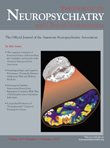Chromosomal Translocation t(1;4) (p21;p14) Indicating Possible Susceptibility Loci for Schizophreniform Disorder and Mental Retardation
SIR: Family, twin, and adoption studies have provided evidence that genetic factors play an important role in the predisposition to mental disorders. However, it has proved difficult to identify the genes involved in this susceptibility. As some cases of mental disorders may be related to chromosomal abnormalities, 1 these situations are valuable resources for helping to find the genes involved in their etiopathogenesis. 2 It is unrealistic to perform cytogenetic analysis on all psychiatric patients. However, there are some groups of patients for whom screening for cytogenetic abnormality should be considered, particularly those with a) strong family histories of psychiatric disorders, b) mental retardation or a strong family history of such a condition, or c) the presence of physical dysmorphisms (indicators of disturbed prenatal development of the ectoderm, which is the embryological structure responsible for the constitution of the skin and its annexes, and CNS). 2 This letter presents the case of a patient with mild mental retardation, schizophrenia, and physical dysmorphisms, with the aim to discuss chromosomal abnormalities as a condition to indicate loci “hot spots” to be investigated.
Case Report
An 18-year-old male patient with history of mild mental retardation and physical anomalies, such as clinodactyly and epicanthal fold, started to present with delusions, hallucinations, aggressive behavior, disorganized speech, affective flattening, avolition, and social isolation (features indicative of schizophrenia). Because of the diagnosis of mental retardation and the physical abnormalities, the patient was submitted to a cytogenetic study which identified a balanced translocation t(1;4) (p21;p14) without loss of material. His parents did not show chromosomal abnormalities.
Comment
Cytogenetic abnormalities may provide a valuable clue to the identification of target loci. One such success story was the discovery of the genes DISC1 and DISC2 (disrupted in schizophrenia) on chromosome 1 where an inherited reciprocal translocation between chromosomes 1 and 11 was segregated with schizophrenia and other psychiatric disorders in a large multigenerational pedigree from Scotland. 3 When a chromosomal abnormality is detected in someone with a psychiatric illness, it may be considered noncoincidental and related to the disorder if some criteria are met, one of them being the existence of independent reports of the association of such abnormalities with the psychiatric disorder. The chromosomal breakpoints observed in our case report (1p22 and 4p14) are located extremely close to regions described previously by two other reports. Gordon et al. 4 described a case of a reciprocal translocation t 1 (p22;q21.3) in a patient with childhood onset schizophrenia, autism and mental retardation. Palmour et al. 5 reported a case of a schizophrenic patient with inversion on chromosome 1 (p15.2q21.3) and the proband’s mother who had the same inversion and schizotypic traits. Thus, the loci 1p22 and 4p14 may be interesting regions for genetic investigations on schizophreniform disorders and mental retardation.
1 . Akanuma N, Saitoh O, Yoshikawa T, et al: Interictal schizophrenia-like psychosis in a patient with double cortex syndrome. J Neuropsychiatry Clin Neurosci 2002; 14:210–213Google Scholar
2 . MacIntyre DJ, Blackwood DHR, Porteous BS, et al: Chromosomal abnormalities and mental illness. Mol Psychiatry 2003; 8:275–287Google Scholar
3 . Blackwood DH, Fordyce A, Walker MT, et al: Schizophrenia and affective disorders: cosegregation with a translocation at chromosome 1q42 that directly disrupts brain-expressed genes: clinical and P300 findings in a family. Am J Hum Genet 2001; 69:428–433Google Scholar
4 . Gordon CT, Krasnewich D, White B, et al: Brief report: translocation involving chromosomes 1 and 7 in a boy with childhood-onset schizophrenia. J Autism Dev Disor 1994;24:537:545Google Scholar
5 . Palmour RM, Miller S, Fielding A, et al: A contribution to the differential diagnosis of the “group of schizophrenias”: structuralabnormality of chromosome 4. J Psychiatry Neurosci 1994; 19:270–277Google Scholar



